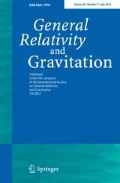Abstract
We consider d-dimensional solutions to the electrovacuum Einstein–Maxwell equations with the Weyl tensor of type N and a null Maxwell \((p+1)\)-form field. We prove that such spacetimes are necessarily aligned, i.e. the Weyl tensor of the corresponding spacetime and the electromagnetic field share the same aligned null direction (AND). Moreover, this AND is geodetic, shear-free, non-expanding and non-twisting and hence Einstein–Maxwell equations imply that Weyl type N spacetimes with a null Maxwell \((p+1)\)-form field belong to the Kundt class. Moreover, these Kundt spacetimes are necessarily \({ CSI}\) and the \((p+1)\)-form is \({ VSI}\). Finally, a general coordinate form of solutions and a reduction of the field equations are discussed.
Similar content being viewed by others
Notes
\(\varvec{T}\) is a \({ CSI}\) (constant scalar invariant) tensor if all scalar polynomial invariants constructed from \(\varvec{T}\) and its covariant derivatives of arbitrary order are constant. If, moreover, all these scalar invariants vanish, we say that \(\varvec{T}\) is a VSI (vanishing scalar invariant) tensor. \({ CSI}\)/\({ VSI}\) spacetime is then a spacetime whose Riemann tensor is \({ CSI}\)/\({ VSI}\), see [11,12,13] and [14,15,16], respectively (see also [3] and reference therein).
For \(\tilde{\varvec{F}}=\varvec{F}\), equations (3.10) reduce to the Maxwell equations.
As in [23], we consider behaviour of scalars with respect to constant boosts.
References
Milson, R., Coley, A., Pravda, V., Pravdová, A.: Alignment and algebraically special tensors in Lorentzian geometry. Int. J. Geom. Methods Mod. Phys. 2(01), 41–61 (2005)
Coley, A., Milson, R., Pravda, V., Pravdová, A.: Classification of the Weyl tensor in higher dimensions. Class. Quantum Gravity 21(7), L35 (2004)
Ortaggio, M., Pravda, V., Pravdová, A.: Algebraic classification of higher dimensional spacetimes based on null alignment. Class. Quantum Gravity 30(1), 013001 (2013)
Ortaggio, M.: Bel-debever criteria for the classification of the Weyl tensors in higher dimensions. Class. Quantum Gravity 26, 195015 (2009)
Podolský, J., Švarc, R.: Interpreting spacetimes of any dimension using geodesic deviation. Phys. Rev. D 85(4), 044057 (2012)
Ortaggio, M., Pravda, V.: Electromagnetic fields with vanishing scalar invariants. Class. Quantum Gravity 33(11), 115010 (2016)
Stephani, H., Kramer, D., MacCallum, M., Hoenselaers, C., Herlt, E.: Exact Solutions of Einstein’s Field Equations. Cambridge University Press, Cambridge (2003)
Durkee, M., Pravda, V., Pravdová, A., Reall, H.S.: Generalization of the Geroch–Held–Penrose formalism to higher dimensions. Class. Quantum Gravity 27(21), 215010 (2010)
Wils, P.: Homogeneous and conformally Ricci flat pure radiation fields. Class. Quantum Gravity 6(9), 1243 (1989)
Kuchynka, M., Pravdová, A.: Spacetimes of Weyl and Ricci type N in higher dimensions. Class. Quantum Gravity 33(11), 115006 (2016)
Coley, A., Hervik, S., Pelavas, N.: On spacetimes with constant scalar invariants. Class. Quantum Gravity 23(9), 3053 (2006)
Coley, A., Hervik, S., Pelavas, N.: Lorentzian spacetimes with constant curvature invariants in four dimensions. Class. Quantum Gravity 26, 125011 (2009)
Coley, A., Hervik, S., Pelavas, N.: Lorentzian manifolds and scalar curvature invariants. Class. Quantum Gravity 27, 102001 (2010)
Pravda, V., Pravdová, A., Coley, A., Milson, R.: All spacetimes with vanishing curvature invariants. Class. Quantum Gravity 19, 6213–6236 (2002)
Coley, A., Milson, R., Pravda, V., Pravdová, A.: Vanishing scalar invariant spacetimes in higher dimensions. Class. Quantum Gravity 21(23), 5519 (2004)
Coley, A., Fuster, A., Hervik, S., Pelavas, N.: Higher dimensional VSI spacetimes. Class. Quantum Gravity 23(24), 7431 (2006)
Ortaggio, M., Pravda, V.: Universal electromagnetic fields. in preparation, 2017
Ortaggio, M., Pravda, V., Pravdová, A.: Ricci identities in higher dimensions. Class. Quantum Gravity 24(6), 1657 (2007)
Ortaggio, M.: Higher dimensional spacetimes with a geodesic, shearfree, twistfree and expanding null congruence. arXiv:gr-qc/0701036 (2007)
Podolský, J., Švarc, R.: Explicit algebraic classification of Kundt geometries in any dimension. Class. Quantum Gravity 30(12), 125007 (2013)
Podolský, J., Žofka, M.: General Kundt spacetimes in higher dimensions. Class. Quantum Gravity 26(10), 105008 (2009)
Bičák, J., Pravda, V.: Curvature invariants in type-N spacetimes. Class. Quantum Gravity 15, 1539 (1998)
Hervik, S., Pravda, V., Pravdová, A.: Type III and N universal spacetimes. Class. Quantum Gravity 31, 215005 (2014)
Acknowledgements
We are thankful to M. Ortaggio and V. Pravda for useful comments on the draft. AP acknowledges support from research plan RVO: 67985840 and research Grant GAČR 13-10042S.
Author information
Authors and Affiliations
Corresponding author
Appendix A: Curvature invariants in Kundt spacetimes of Weyl and traceless Ricci type N
Appendix A: Curvature invariants in Kundt spacetimes of Weyl and traceless Ricci type N
Let us study scalar curvature invariants in the Kundt subclass of Weyl type N spacetimes with the Ricci tensor of the form
where \(\tilde{\Lambda }\) is a constant, \(\eta \) is a scalar and \(\varvec{k}\) is a null vector. In general, a Kundt vector in a Ricci type II spacetime is necessarily a multiple WAND (see e.g. Proposition 2 of [18]). Thus, in our case, it must coincide with the common AND \(\varvec{\ell }\) of the Weyl and the Ricci tensor. Hence, the spacetime is of Riemann type II (i.e. the Riemann tensor is of type II) with the Kundt AND \(\varvec{\ell }\). In addition to this, all boost weight zero null frame components of the Riemann tensor are constant (depending on \(\tilde{\Lambda }\)).
If \(\tilde{\Lambda }= 0\), the Riemann tensor is of type N and it is aligned with the Kundt vector \(\varvec{\ell }\). Thus, according to Theorem 1 of [15] on characterization of VSI spacetimes, the corresponding spacetime is VSI.
If \(\tilde{\Lambda }\) is non-vanishing, then the spacetime is at least \({ CSI}_0\), i.e. all curvature invariants constructed solely from the Riemann tensor (without incorporating its covariant derivatives) are constant. Indeed, any full contraction of a tensor \(\varvec{T}\) is completely determined by its boost weight zero part \(\varvec{T}_{(0)}\). Since in our case, the boost weight zero part \(\varvec{R}_{(0)}\) of the Riemann tensor \(\varvec{R}\) possesses only constant null frame components, also any full contraction of a tensor given by a series of tensor products of the Riemann tensor with itself or with the metric (which consists only of its boost weight zero part) is necessarily constant. See also Sect. 2.3 of [11].
In order to study higher-order invariants constructed using also covariant derivatives of \(\varvec{R}\), we make use of the balanced scalar approach introduced in [14], see also [22]. First, let us define k-balancedness of a tensor.
Definition A.1
We say that a tensor \(\varvec{T}\) is k-balanced if there exists a null vector \(\varvec{\ell }\) such that \( bo _{\varvec{\ell }}(\varvec{T}) < -k\) and for any of its null frame components \(\eta \) with boost weight \(b<-k\), the derivative \(D^{-b-k} \eta \) is zero.
Now, let us prove the following result on k-balancedness of covariant derivatives \(\nabla ^{(n)} \varvec{R}\) of the Riemann tensor.
Proposition A.2
In a Weyl type N Kundt spacetime with the Ricci tensor of the form (A.1), an arbitrary covariant derivative of the Riemann tensor is 1-balanced and thus it is VSI.
Proof
Let us stress out again that such a spacetime is necessarily aligned [10], and hence without loss of generality one can assume that \(\varvec{k}= \varvec{\ell }\). Also, using the notation of the GHP formalism [8], the boost weight \((-2)\) component of the Ricci tensor reads \(\omega ^{\prime }= \eta \).
Consider the Ricci decomposition of the Riemann tensor [7],
where \(\varvec{G}\) is the so-called scalar part (\(G_{abcd} \propto R g_{a[c}g_{d]b}\) ), \(\varvec{E}\) is the semi-traceless part (\(E_{abcd} \propto g_{a[c}S_{d]b}-g_{b[c}S_{d]a}\), \(S_{ab}\) being the traceless part of the Ricci tensor) and the Weyl tensor \(\varvec{C}\) is the fully traceless part of the Riemann tensor.
Since the Ricci scalar R is constant (\(R \propto \tilde{\Lambda }\)), we have \(\nabla \varvec{G} = \varvec{0}\) and hence
For Weyl type N Kundt spacetimes with the Ricci tensor of the form (A.1), Eqs. (28)–(30) in [23] are still valid together with \(D\omega '=0\) and thus the following generalizations of Lemmas 4.2 and 4.3 in [23] are also valid.Footnote 3
Lemma A.3
In a Weyl type N Kundt spacetime with the Ricci tensor of the form (A.1), for a 1-balanced scalar \(\eta \), scalars \(L_{11} \eta \), \(\tau _i \eta \), \(L_{1i}\eta \), \( \kappa '_i \eta \), \( \rho '_{ij} \eta \), \(\mathop {M}\limits ^{i}_{j1} \eta \), \( \mathop {M}\limits ^{i}_{kl} \eta \) and \(D \eta ,\ \delta _i \eta ,\ \bigtriangleup \eta \) are also 1-balanced scalars.
Lemma A.4
In a Weyl type N Kundt spacetime with the Ricci tensor of the form (A.1), a covariant derivative of a 1-balanced tensor is again a 1-balanced tensor.
Since the Weyl tensor and the traceless part of the Ricci tensor, \(\eta \ell _a\ell _b\), as well as \(\varvec{E}\) are 1-balanced, their arbitrary derivative is also 1-balanced and so is any covariant derivative of the Riemann tensor, i.e. \(\nabla ^{(k)} \varvec{R}\) is 1-balanced for any \(k \in \mathbb {N}\). \(\square \)
Thus, although the Riemann tensor is not VSI, its first covariant derivative is. In particular, this means that the only non-trivial scalar curvature invariants are precisely those constructed from the Riemann tensor itself. However, we already know that all these invariants are necessarily constant. Therefore, we immediately obtain the following result.
Corollary A.5
A Weyl type N Kundt spacetime with the Ricci tensor of the form (A.1) is \({ CSI}\).
Rights and permissions
About this article
Cite this article
Kuchynka, M., Pravdová, A. Weyl type N solutions with null electromagnetic fields in the Einstein–Maxwell p-form theory. Gen Relativ Gravit 49, 71 (2017). https://doi.org/10.1007/s10714-017-2234-7
Received:
Accepted:
Published:
DOI: https://doi.org/10.1007/s10714-017-2234-7



